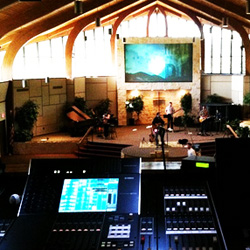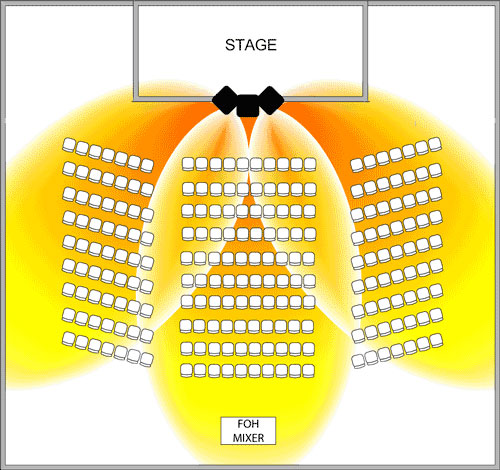
Example #2: A Mid-Sized Contemporary House Of Worship
Description:
This second example is a medium sized house of worship. The vaulted ceiling is high and the floor in the congregational seating area is covered with hard-industrial vinyl.
The RT60 is longer then the first example at approximately 1.5 seconds so reverberation is a problem in an empty room. The sources of audio are again ministers on a microphone and a worship band.
Control is via a 32-channel mixer. The speaker system is an array of three large boxes mounted as a central cluster high in the peak of the ceiling. A professional audio company did the installation and calibration of the audio system.
The quality of the audio in this church is much better than in the first example. An interesting question is: how good is “good enough”? When interviewed, members of this congregation can usually hear. Rarely is the audio painful to listen to so some say that the audio quality is fully acceptable.
This is a good time to reflect back on the example in the introduction where domed ceilings were held up as an icon of natural acoustic wonderfulness. Let’s examine each individual audio characteristic previously discussed and see how this audio system installation stacks up.
Problems
Reverberance is not well controlled and is dependent on the configuration and occupancy of the room. Low-mid frequencies are a particular problem as the energy builds up and is never trapped or controlled.
•Clarity is fairly good and meets a minimum standard. But articulation is acceptable but not outstanding. The ALCONs (Articulation Loss of Consonants) rating of this room is fairly low but in the acceptable range. However, there is room for improvement.
•Listener envelopment is nonexistent and completely pales in comparison to the example of a domed ceiling.
•Again, as in the first example, an experienced sound person is required to run the mixer for any use of the audio system, as there is no automation in the audio system.
•There is good coverage of the congregation from the central cluster, but people sitting in the area where the coverage patterns between two of the loudspeakers overlap experience uneven frequency response due to the comb filtering caused by the interference between these two loudspeakers.
•Bass response is particularly poor. The poor bass response leads to the impression that the system lacks sufficient power.
Recommendations:
A DSP is already in the system and can be used for additional equalization and other tasks. The same recommendation applies to add enough automation so that a simple service can be done without bringing in a sound person.
The loudspeaker system may already be fully adequate. The first temptation may be to add a subwoofer to add bass power, but after a quick survey it is probable that the buildup of mid-bass energy in this room makes the quality of the bass so poor that adding more bass will only make matters worse.
To fix the room, the ceiling and walls could be completely covered in bass absorptive panels, but this is not really practical so a compromise is to add bass traps to the corners of the room and the ridge of the ceiling.
If it is not possible to tame the room with traps, then narrow-band filtering techniques could be employed.
This is where the room is evaluated for the natural modes that build up energy in the room and these frequencies are notched out with a very narrow filter. A combination of some absorptive panels and narrow-band filters might be the best compromise.
There are regions (as shown in Figure 15) where the coverage from the individual speakers in the cluster interfere with each other rather than combine cooperatively. This interference is frequency-dependent.
The solution is to reduce the contribution of some of the loudspeakers of those problem frequencies so that interference is minimized. The system would then require re-calibration to complement the above changes. That should do it.
At the time of publication Michaël Rollins was a senior digital design engineer for Rane Corporation. This and other educational articles are available in the RaneNotes Library, a subset of the Rane Pro Audio Reference.

